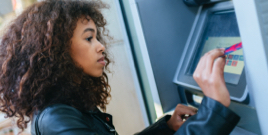8 checking account features everyone should know
These checking account benefits make it easier to manage your money
Read, 6 minutes
A checking account is the account you’ll most likely use on a daily basis to deposit your paycheck, pay bills, access cash and transfer funds. But if you want to get the most out of your checking account, here are eight important features that can help you manage your money.
Set up direct deposit
One of the biggest benefits of a checking account is that you can set up direct deposit. Direct deposit is a fast and safe way to deposit money into your account, without having to lift a finger. Your employer probably already offers this convenience and will ask you to sign up for it. And of course, you can still deposit funds using a teller, ATM, app or account transfer.
Sign up for mobile and online banking
Enrolling in online banking means you can monitor your accounts, including your balance and transaction history, simply by logging in. Mobile banking allows you to do the same via your phone or tablet. Additionally, by banking online you can quickly order checks, pay bills, transfer money, track spending, set alerts and travel flags, and manage your accounts from almost anywhere.
Article continues below
Related content
Understand your debit card
Most checking accounts come with a debit card. You can use your debit card to make purchases at a store or online and to withdraw or deposit money at ATMs. Debit cards can also be added to digital wallets on your phone. With debit cards, your purchases and withdrawals are deducted directly from your checking account. Debit cards can also offer security if your card is lost or stolen or if fraudulent purchases occur.
Learn to transfer money between accounts
If you have a checking and savings account at the same bank, it’s fairly easy to transfer money between your accounts. If you’re working toward a savings goal, consider setting up automatic transfers to your savings account at a time each month when you know you have a certain amount of money in your checking account. Automating the process can be a great way to build your savings.
Know how to avoid overdraft fees
When you spend more money than you have in your account most banks will charge an overdraft fee, though the fee varies for different banks. The best way to avoid these fees is to monitor your account balance or to set up alerts when it drops below a certain amount. Many banks offer optional overdraft protection services which allow you to link your checking account to other eligible accounts to cover you in case of an overdraft. Some banks charge a fee for this service, and others offer the service without a fee. Some banks enroll you in certain overdraft-related services automatically. Whether the protection is optional or automatic, be sure to review your account’s overdraft policies before signing up.
Turn on alerts
If you’re enrolled in online banking, you can set up alerts to notify you via email or text of certain activity. For example, you can set up balance alerts for when the funds in your account drop below a certain amount or alerts for unusual account activity. Just make sure your bank has your up-to-date cell phone number and email address.
Set up automatic payments
Setting up automatic payments for recurring bills can help ensure you pay your bills on time with no hassles. This common checking account feature can help free up your time, avoid costly late fees and keep your credit in good health.
Know how you’re protected
Many banks offer security features, such as photo ID, chip technology or monitoring for unusual purchasing, to help protect you if your debit card is lost or stolen. Some banks may allow you to put a virtual lock on your card via your mobile or online account if you suspect the card has been lost or stolen.
Check with your bank to learn more about the security features it offers to help protect against fraud. It’s also important to know that federal law limits your responsibility if your debit card is stolen, but you must act quickly to notify your bank.
